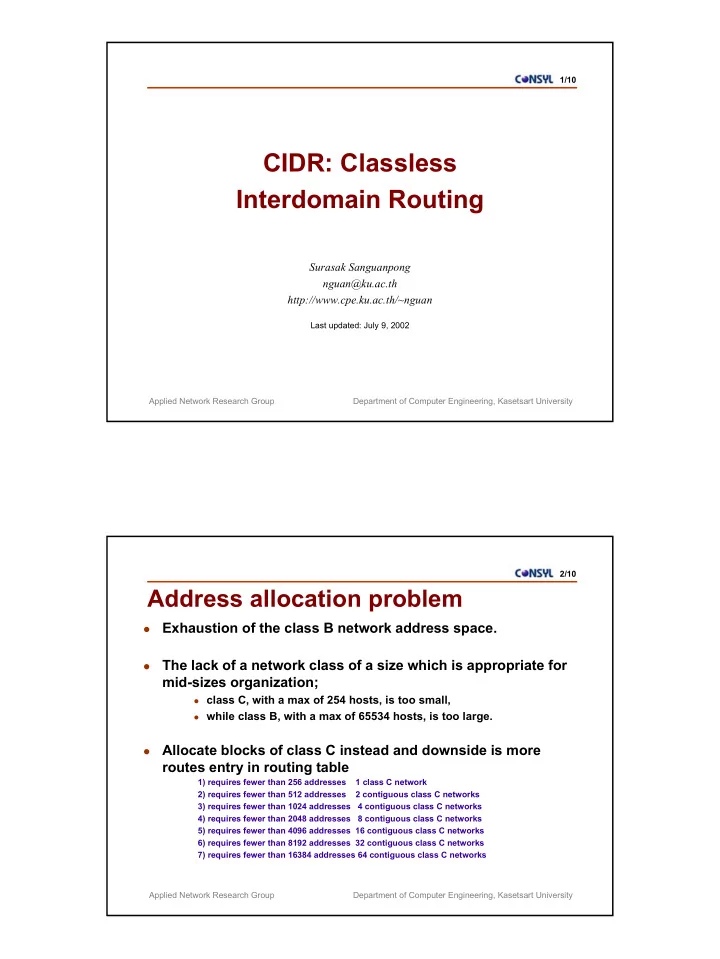

1/10 CIDR: Classless Interdomain Routing Surasak Sanguanpong nguan@ku.ac.th http://www.cpe.ku.ac.th/~nguan Last updated: July 9, 2002 Applied Network Research Group Department of Computer Engineering, Kasetsart University 2/10 Address allocation problem Exhaustion of the class B network address space. � The lack of a network class of a size which is appropriate for � mid-sizes organization; � class C, with a max of 254 hosts, is too small, � while class B, with a max of 65534 hosts, is too large. Allocate blocks of class C instead and downside is more � routes entry in routing table 1) requires fewer than 256 addresses 1 class C network 2) requires fewer than 512 addresses 2 contiguous class C networks 3) requires fewer than 1024 addresses 4 contiguous class C networks 4) requires fewer than 2048 addresses 8 contiguous class C networks 5) requires fewer than 4096 addresses 16 contiguous class C networks 6) requires fewer than 8192 addresses 32 contiguous class C networks 7) requires fewer than 16384 addresses 64 contiguous class C networks Applied Network Research Group Department of Computer Engineering, Kasetsart University
3/10 Routing Table problems Issue multiple (block) class C addresses (instead single class � B address) solves a running out of class B address but... Introduces a problem of routing table � � By default, a routing table contains an entry for every network � How large a routing table should be for all Class C networks? Growth of routing table in the Internet routers beyond the � ability of current software and hardware to manage Applied Network Research Group Department of Computer Engineering, Kasetsart University 4/10 Route Non-Aggregation แสดงทิศทาง Internet การประกาศเสนทาง 202.0.1.0/24, 202.0.32.0/24, 202.0.2.0/24, 202.0.33.0/24, ISP1 202.0.3.0/24 202.0.0.0 - 202.0.1.0/24, 202.0.255.0 202.0.2.0/24, 202.0.32.0/24, 202.0.3.0/24 202.0.33.0/24 202.0.0.0 - 202.0.32.0 - ISP2 ISP3 202.0.15.0 202.0.47.0 202.0.1.0 202.0.3.0 202.0.32.0 202.0.33.0 202.0.2.0 Applied Network Research Group Department of Computer Engineering, Kasetsart University
5/10 BGP routing Table 115000 110000 อัตราการเติบโตของตารางเสนทางในอินเทอรเน็ต 105000 100000 ที่มา : http://www.mcvax.org/~jhma/routing/bgp-hist.html 95000 90000 85000 80000 75000 70000 65000 60000 55000 50000 45000 40000 35000 30000 25000 20000 15000 10000 5000 0 Jun-88 Jun-90 Jun-92 Jun-94 Jun-96 Jun-98 Jun-00 Applied Network Research Group Department of Computer Engineering, Kasetsart University 6/10 How to Solve Topological allocate IP address assignment � We divide the world into 8 regions like this : (RFC1466) � Multi-regional 192.0.0.0 - 193.255.255.255 Europe 194.0.0.0 - 195.255.255.255 Others 196.0.0.0 - 197.255.255.255 North America 198.0.0.0 - 199.255.255.255 Central/South America 200.0.0.0 - 201.255.255.255 Pacific Rim 202.0.0.0 - 203.255.255.255 Others 204.0.0.0 - 205.255.255.255 Others 206.0.0.0 - 207.255.255.255 IANA reserved 208.0.0.0 - 223.255.255.255 Applied Network Research Group Department of Computer Engineering, Kasetsart University
7/10 Route Aggregation แสดงทิศทาง Internet การประกาศเสนทาง 202.0.0.0/16 ISP1 202.0.0.0/16 202.0.32.0/20 202.0.0.0/20 ISP2 202.0.0.0/20 202.0.32.0/20 ISP3 202.0.1.0 202.0.3.0 202.0.32.0 202.0.33.0 202.0.2.0 Applied Network Research Group Department of Computer Engineering, Kasetsart University 8/10 Classless Interdomain Routing Class C address’s concept becomes meaningless on these � route between ‘domains’, the technique is called Classless Interdomain Routing or CIDR (pronounce cider) Key concept is to allocate multiple IP addresses in the way � that allow summarization into a smaller number of routing table (route aggregate) CIDR is supported by BGP4 and based on route aggregation � � e.g 16 class C addresses can be summarized to a single routing entry (router can hold a single route entry for the main trunks between these areas Applied Network Research Group Department of Computer Engineering, Kasetsart University
9/10 Supernetting CIDR is also called Supernetting in contrast to subnetting � an organization has been allocated a block of class C � addresses in 2 n with contiguous address space � archive by using bits which belongs to the network address as host bits � class C example : altering the default class C subnet mask such that some bit change from 1 to 0 (Super) netmask 4 class C networks appear 11111111 11111111 11111100 00000000 to networks outside as a single network 255.255.252.0 Applied Network Research Group Department of Computer Engineering, Kasetsart University 10/10 Supernetting Sample � an organization with 4 class C � 190.0.32.0, 190.0.33.0, 190.0.34.0 190.0.35.0 11111111 11111111 11111100 00000000 mask = 255.255.255.252.0 11000010 00000000 001000 00 00000000 net = 190.0.32.0 11000010 00000000 001000 01 00000000 net = 190.0.33.0 11000010 00000000 001000 10 00000000 net = 190.0.34.0 11000010 00000000 001000 11 00000000 net = 190.0.35.0 Bit wise AND results 190.0.32.0 This organization’s network has changed from 4 net to a single net � with 1022 hosts Applied Network Research Group Department of Computer Engineering, Kasetsart University
11/10 The Longest Match Supernetting Europe has 194.0.0.0 - 195.255.255.255 with mask 254.0.0.0 � A case of one organization (195.0.16.0-195.0.36.0 mask � 255.255.254.0) needs different routing entry datagrams 195.0.20.1 matches both Europe’s and this � organization. How to do? Routing mechanism selects the longest mask (255.255.254.0 is � longer than 254.0.0.0), then route to the organization Applied Network Research Group Department of Computer Engineering, Kasetsart University 12/10 Summary � routing decisions are now made based on masking operations of the entire 32 bit address, hence the term “classes” � No existing routes is changed � CIDR slows down the growth of routing tables (current ~ 50K entries in core routers) � Short term solution to solve routing problem � limitation : not all host/router software allows supernet mask Applied Network Research Group Department of Computer Engineering, Kasetsart University
Recommend
More recommend